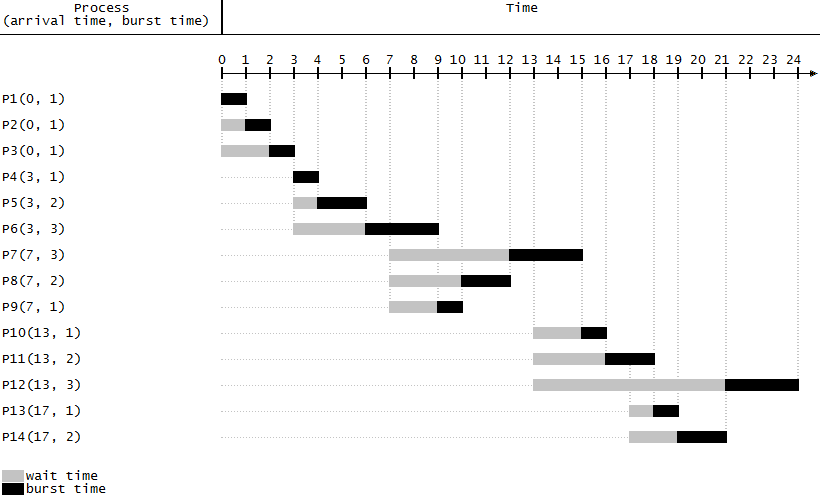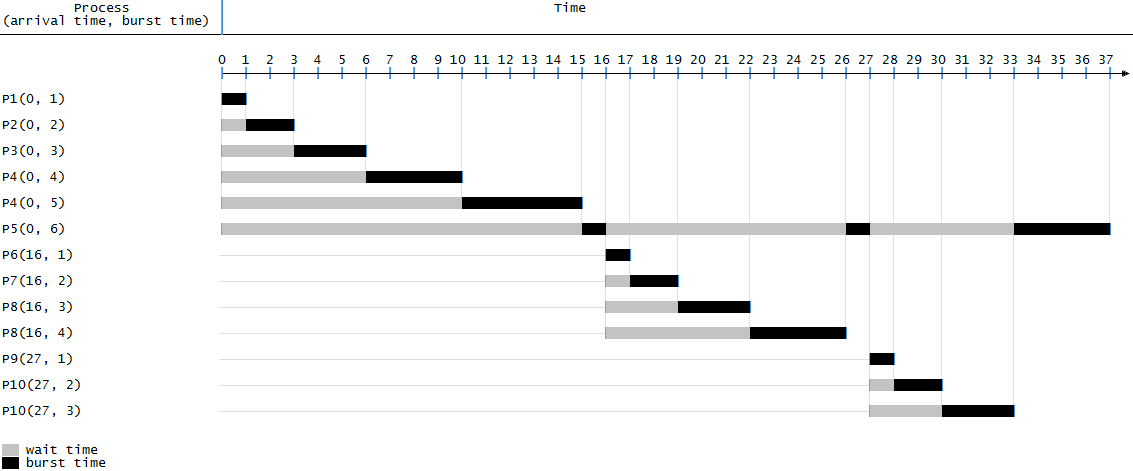|
Highest Response Ratio Next
Highest response ratio next (HRRN) scheduling is a non-preemptive discipline. It was developed by Brinch Hansen as modification of shortest job next or shortest job first (SJN or SJF) to mitigate the problem of process starvation. In HRRN, the next job is not that with the shortest estimated run time, but that with the highest response ratio defined as response\ ratio = \frac = 1 + \frac This means, the jobs that have spent a long time waiting compete against those estimated to have short run times. As you can see in the above equation of response ratio, if the waiting time of a process increases, its response ratio increases making the long-awaited process to execute next. So, this algorithm solves the starvation problem that exists in SJN scheduling algorithm. Algorithm Given a Linked list Q, iterate through Q to find the highest ratio by comparing each ratio within the queue. Once a ratio of element N is greater than the element M with the highest ratio replace element M wi ... [...More Info...] [...Related Items...] OR: [Wikipedia] [Google] [Baidu] |
Scheduling (computing)
In computing, scheduling is the action of assigning ''resources'' to perform ''tasks''. The ''resources'' may be processors, network links or expansion cards. The ''tasks'' may be threads, processes or data flows. The scheduling activity is carried out by a process called scheduler. Schedulers are often designed so as to keep all computer resources busy (as in load balancing), allow multiple users to share system resources effectively, or to achieve a target quality-of-service. Scheduling is fundamental to computation itself, and an intrinsic part of the execution model of a computer system; the concept of scheduling makes it possible to have computer multitasking with a single central processing unit (CPU). Goals A scheduler may aim at one or more goals, for example: * maximizing ''throughput'' (the total amount of work completed per time unit); * minimizing ''wait time'' (time from work becoming ready until the first point it begins execution); * minimizing '' latency ... [...More Info...] [...Related Items...] OR: [Wikipedia] [Google] [Baidu] |
Preemption (computing)
In computing, preemption is the act of temporarily interrupting an executing task, with the intention of resuming it at a later time. This interrupt is done by an external scheduler with no assistance or cooperation from the task. This preemptive scheduler usually runs in the most privileged protection ring, meaning that interruption and resuming are considered highly secure actions. Such a change in the currently executing task of a processor is known as context switching. User mode and kernel mode In any given system design, some operations performed by the system may not be preemptable. This usually applies to kernel functions and service interrupts which, if not permitted to run to completion, would tend to produce race conditions resulting in deadlock. Barring the scheduler from preempting tasks while they are processing kernel functions simplifies the kernel design at the expense of system responsiveness. The distinction between user mode and kernel mode, which ... [...More Info...] [...Related Items...] OR: [Wikipedia] [Google] [Baidu] |
Per Brinch Hansen
Per Brinch Hansen (13 November 1938 – 31 July 2007) was a Danish-American computer scientist known for his work in operating systems, concurrent programming and parallel and distributed computing. Biography Early life and education Per Brinch Hansen was born in Frederiksberg, an enclave surrounded by Copenhagen, Denmark. His father, Jørgen Brinch Hansen, worked as a civil engineer, becoming a leading expert in soil mechanics, and later accepting a professorship at Technical University of Denmark. His mother, Elsebeth Brinch Hansen (née Ring), was the daughter of Danish composer Oluf Ring and worked as a hairdresser before marrying. Brinch Hansen attended Skt. Jørgens Gymnasium and then studied electrical engineering at Technical University of Denmark where he sought an area to pursue that "was still in its pioneering phase" on the belief that "If a subject was being taught, it was probably already too late to make fundamental contributions." After a seven-week student ... [...More Info...] [...Related Items...] OR: [Wikipedia] [Google] [Baidu] |
Shortest Job Next
Shortest job next (SJN), also known as shortest job first (SJF) or shortest process next (SPN), is a scheduling policy that selects for execution the waiting process with the smallest execution time. SJN is a non- preemptive algorithm. Shortest remaining time is a preemptive variant of SJN. Shortest job next is advantageous because of its simplicity and because it minimizes the average amount of time each process has to wait until its execution is complete. However, it has the potential for process starvation for processes which will require a long time to complete if short processes are continually added. Highest response ratio next is similar but provides a solution to this problem using a technique called aging. Another disadvantage of using shortest job next is that the total execution time of a job must be known before execution. While it is impossible to predict execution time perfectly, several methods can be used to estimate it, such as a weighted average of previous exec ... [...More Info...] [...Related Items...] OR: [Wikipedia] [Google] [Baidu] |
Process Starvation
A process is a series or set of activities that interact to produce a result; it may occur once-only or be recurrent or periodic. Things called a process include: Business and management *Business process, activities that produce a specific service or product for customers *Business process modeling, activity of representing processes of an enterprise in order to deliver improvements *Manufacturing process management, a collection of technologies and methods used to define how products are to be manufactured. *Process architecture, structural design of processes, applies to fields such as computers, business processes, logistics, project management *Process costing, a cost allocation procedure of managerial accounting * Process management, ensemble of activities of planning and monitoring the performance of a business process or manufacturing processes *Process management (project management), a systematic series of activities directed towards causing an end result in engineeri ... [...More Info...] [...Related Items...] OR: [Wikipedia] [Google] [Baidu] |
Shortest Remaining Time
Shortest remaining time, also known as shortest remaining time first (SRTF), is a scheduling method that is a preemptive version of shortest job next scheduling. In this scheduling algorithm, the process with the smallest amount of time remaining until completion is selected to execute. Since the currently executing process is the one with the shortest amount of time remaining by definition, and since that time should only reduce as execution progresses, the process will either run until it completes or get preempted if a new process is added that requires a smaller amount of time. Shortest remaining time is advantageous because short processes are handled very quickly. The system also requires very little overhead since it only makes a decision when a process completes or a new process is added, and when a new process is added the algorithm only needs to compare the currently executing process with the new process, ignoring all other processes currently waiting to execute. Lik ... [...More Info...] [...Related Items...] OR: [Wikipedia] [Google] [Baidu] |


